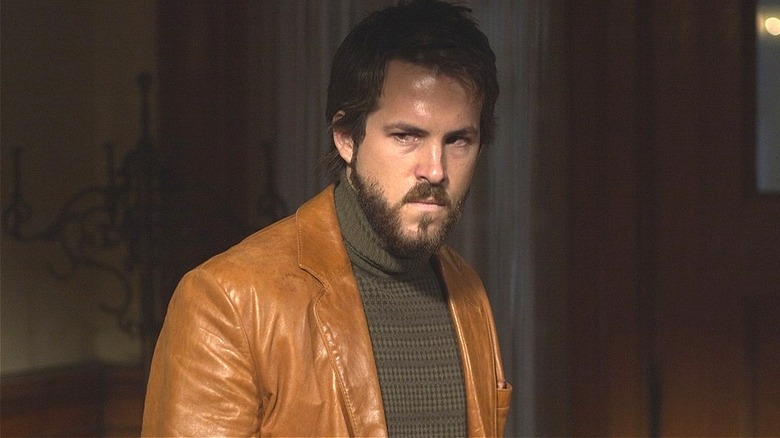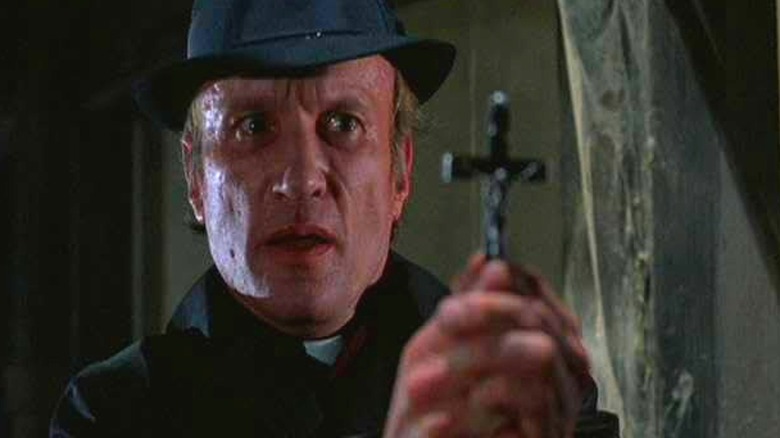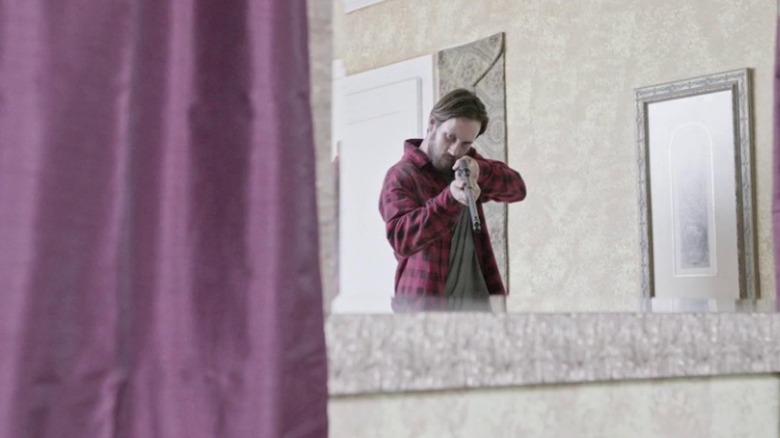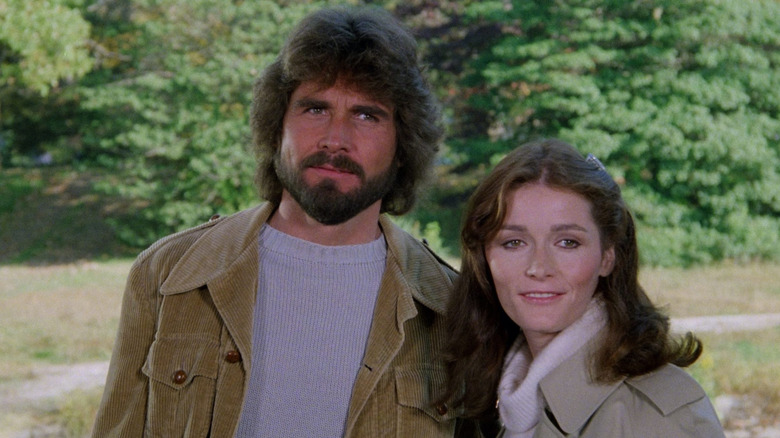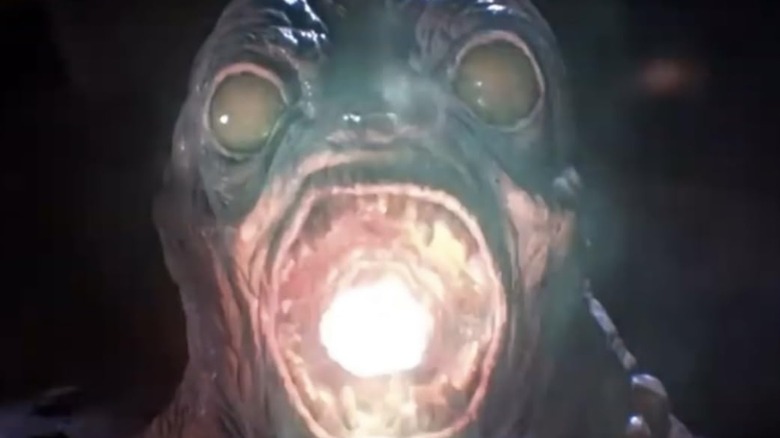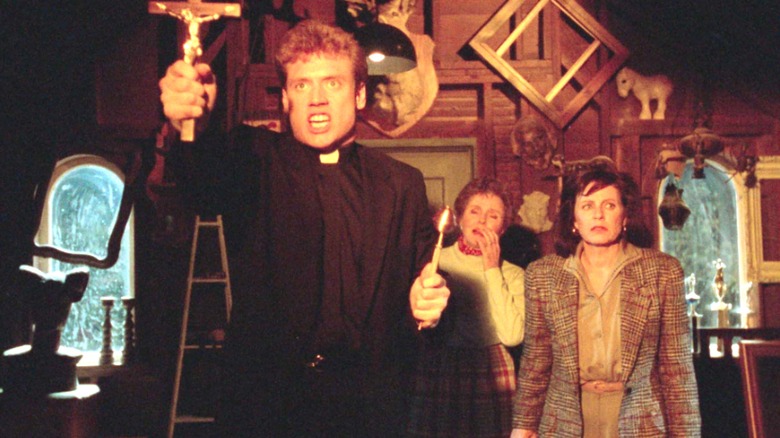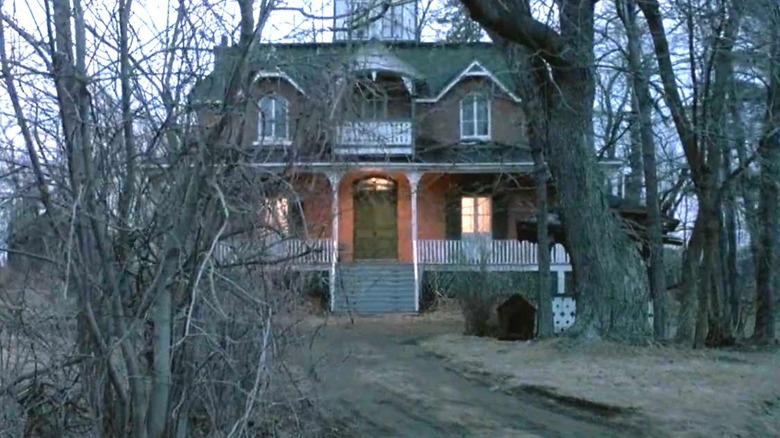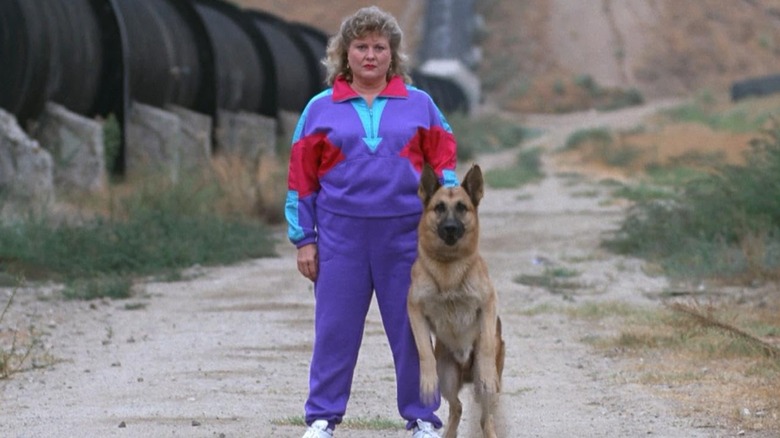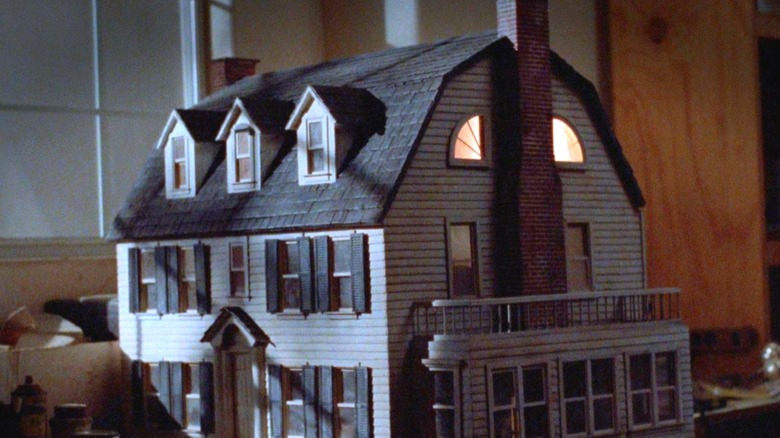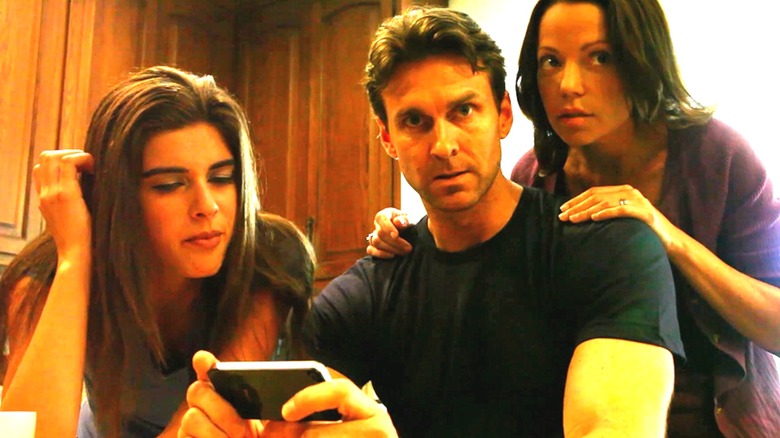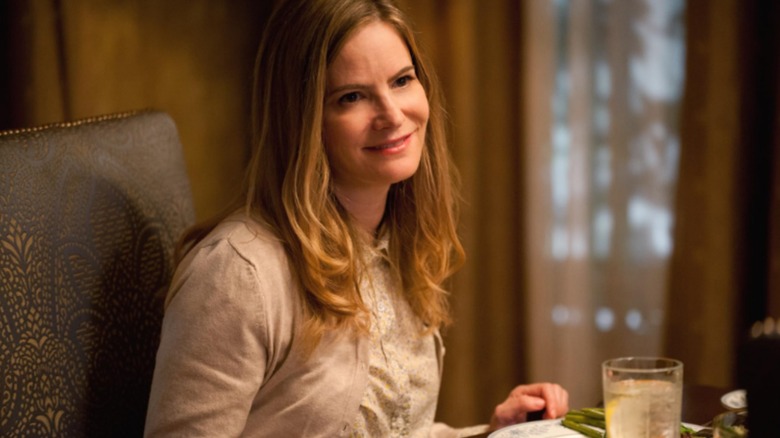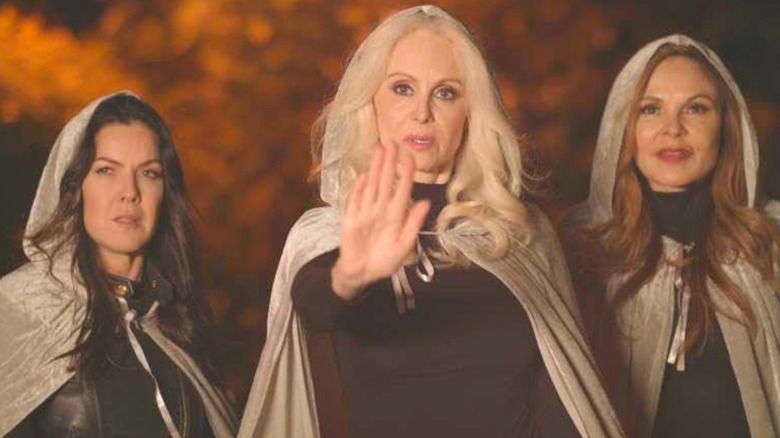How To Watch The Amityville Horror Movies In Order
Spawned from a case first investigated by Ed and Lorraine Warren, the real-world paranormal investigators that the "Conjuring" universe is based on, the 1979 film "The Amityville Horror" would prove to be just the beginning of a completely unhinged pseudo-canon. That's because the "Amityville" universe is based on two things that cannot be trademarked even in the hyper-litigious world of U.S. intellectual property law — a real news story, and an actual location.
This means that, while there are a handful of Amityville films associated with that first Warner Bros. release, dozens of films have been made that bear the name. While all are to varying degrees connected to the 1977 novel about the allegedly haunted 1925 Dutch Colonial Long Island home where Ron DeFeo killed six family members in 1974, the big tent of Amityville movies includes a little bit of everything — a witch movie, a werewolf film, even a sexually explicit entry. As Michael Stone of Rotted Reviews put it, "I could fart on camera for an hour and a half and legally release it as 'Amityville Gas Chamber' and nobody would have any rights to sue me."
With this in mind, the best way to watch the extended Amityville universe is to start with the films related to the original story in a certain order and then consume the rest of the movies in order of release. It sounds a little complicated, but it's really quite simple. Here's the best viewing order:
-
"Amityville II: The Possession" (1982)
-
"The Amityville Murders" (2018)
-
"The Amityville Horror" (1979 and 2005)
-
"Amityville 3-D" (1983)
-
"Amityville 4: The Evil Escapes" (1989)
-
"The Amityville Curse" (1990)
-
"Amityville: It's About Time" (1992)
-
"Amityville: A New Generation" (1993)
-
"Amityville Dollhouse" (1996)
-
"The Amityville Haunting" (2011)
-
"Amityville: The Awakening" (2017)
-
The various Amityville indie films
Amityville II: The Possession (1982)
In a crime that has baffled criminologists and captured the imaginations of paranormal believers for decades, a then-23-year-old Ron "Butch" DeFeo Jr. shot his parents and four younger siblings, ranging in ages from nine to 18. Although author Ric Osuna would later point to the family's abusive patriarch and his alleged ties to organized crime as potential factors in the DeFeos' demise, supernatural claims from the home's future owners would eclipse any real tragedy in the public imagination.
"Amityville II: The Possession" is the fictionalized retelling of those real-world horrors that ignited the lore of 112 Ocean Avenue with the DeFeos reimagined as another large Italian-American family, the Montellis. Like the real Ron Sr., Montelli patriarch Anthony (Burt Young) is abusive and miserable. The problem is made worse when the demonically possessed home starts to play dirty tricks and causes the family's relationships to rapidly deteriorate to the point of marital rape and incest.
Much of the film follows the same basic storyline as "The Amityville Horror" — family meets dream home, dream home turns out to be haunted, haunted house turns family homicidal. But what the film does well is establish that this isn't a run-of-the-mill haunting; it's a serious demonic possession replete with all the sacrilege you'd find in "The Exorcist." That's a helpful footnote to have as you settle in for the rest of the "Amityville" saga, making "Amityville II: The Possession" a great entry point.
If you or anyone you know has been a victim of sexual assault, help is available. Visit the Rape, Abuse & Incest National Network website or contact RAINN's National Helpline at 1-800-656-HOPE (4673).
The Amityville Murders (2018)
"The Amityville Murders" is almost a remake of "Amityville II: The Possession," giving viewers a supernatural account of the real story behind the DeFeo murders but using the real family's names. The film, which features a damning zero percent Rotten Tomatoes critical rating, takes the truly horrific true crime story and attempts to infuse it with paranormal meaning, exploitatively suggesting the DeFeo family's tragedy was caused by demonic forces toying with Ron Jr.'s mind.
Given the underlying insensitivity, the reviews are predictably terrible — and it's not just for the problematic premise. The pacing is awful, little effort was put into making the costumes and set historically accurate, and to call the writing middling would be generous. As one IMDb reviewer put it, "Acting was 'meh', watching the mother try to smoke/not smoke that cigarette in the kitchen was painful. Modern doorknobs, electrical outlets and LED candles?" At the end of the day, "The Amityville Murders" at least attempts to tell the real story of the DeFeo family murders, even if it would have been better told as a Netflix documentary.
The Amityville Horror (1979 and 2005)
Although every Amityville saga completionist should watch both the 1979 version of "The Amityville Horror" and the 2005 remake back-to-back for comparison's sake, it really doesn't matter which version you start with. What does matter is that everyone watching the original film today should consider viewing it through Stephen King's "economic horror" lens, outlined in his 1981 non-fiction book "Danse Macabre." King wrote: "The movie might as well have been subtitled The Horror of the Shrinking Bank Account [...] The Amityville Horror, beneath its ghost-story exterior, is really a financial demolition derby."
Both films depict the Lutz family acquiring their Amityville home for well-below market value and right at the limit of what they can afford. Even though they're cool with the whole murder house thing, the bargain starts to fall apart the more they settle in. A door locks a kid in an attic, a priest is unable to bless the home, a nun who visits is stricken with illness, and various other horrifying events plague the family. But the true horror is the family's mental health and emotional stability, which slowly unravel until things start to get violent. While both films generally follow the same storyline, the earlier version, which stars Margot Kidder, James Brolin, and Rod Steiger, is a better film overall despite Ryan Reynolds' strong performance and higher production value aiding the remake.
Amityville 3-D (1983)
Set sometime after "The Amityville Horror," "Amityville 3-D" breaks from the "family moves into a haunted house" formula by placing a sworn skeptic into the Amityville universe. Part of a short-lived 3D craze that came about when studio execs got nervous about the rise in VCRs, "Amityville 3-D" (also known as "Amityville III: The Demon") is chock-full of practical effects and gratuitous 3D usage. Some of the more egregious examples include a red Frisbee zooming slowly toward the audience and a well-monster with serious Large Marge energy, with each 3D moment more ridiculous than the last in all the best ways.
Rip off those 3D glasses and lean a little closer and you'll find there's actually a pretty decent film hidden underneath the gimmick. The story follows science-minded debunker journalist John Baxter (Tony Roberts) as he moves into the Amityville house while in the middle of a divorce. Along with his daughter Susan (Lori Loughlin before "Full House" and her various garage sale Hallmark movies) and Susan's friend Lisa (Meg Ryan in one of her lesser known movie roles), he begins to encounter supernatural events he can't explain. When they learn the home is built on a Native American burial ground and a gateway to Hell for good measure, things become a little more clear.
Amityville 4: The Evil Escapes (1989)
If "Amityville 3D" is where the Amityville universe starts to go a little wonky, the campy, Patty Duke-starring made-for-TV sequel "The Evil Escapes" takes us all the way through the looking glass. After all the demonic force and hellmouth talk of the first few films, the entity possessing the Amityville house has quite literally escaped to avoid getting exorcised by a crew of six priests. Mid-exorcism, the demon absconds into a wonderfully quirky standing floor lamp in a demonic game of hide-and-seek (apparently Latin doesn't penetrate through light bulbs). When a real estate agent hosts a sale a few days later, the lamp gets picked up as a $100 gag gift and shipped off to California.
Strange and worrisome things immediately start happening. The woman who bought the lamp cuts her finger on it and then dies of tetanus; animals go crazy in its presence; and one family member is mysteriously drawn to it. Before long, the story has become totally unhinged — a plumber drowns in sewage; an electrician loses his hand in the garbage disposal; and the family parrot ends up in the toaster. It's ridiculous, wacky, high late-80s fun that reduces the entire lore to a sentient lamp and adds nothing to the franchise. If you don't take your horror movies seriously and can appreciate a so-bad-it's-good flick, you'll love it.
The Amityville Curse (1990)
Released in 1990 and set 12 years after the original Amityville murders, "The Amityville Curse" is adapted from a novel of the same name by Hans Holzer, a real-life parapsychologist and ghost hunter who wrote over a hundred books about the supernatural. From the jump, the film's plot is pretty convoluted and only tangentially connected to the first Amityville story. Sometime after Ron DeFeo murdered his family, a priest is shot to death in a confession booth that is later stored in the clergy house. The booth then gets purchased by a psychologist named Marvin (David Stein) and his wife Debbie (Dawna Wightman).
It should go without saying that the confession booth is cursed, leading to all manner of mayhem, misery, and murder in the home. As the body count climbs, revelations are made about the priest's role in everything. Other than a setting and some loose connections, none of it has much to do with the original Amityville story or even the novel it's meant to be based on. And, like the original DeFeo tragedy, the drama revealed to be behind the cursed confessional booth feels a lot more problematic when looked back on from the 2020s.
Amityville: It's About Time (1992)
A direct-to-video Amityville film that goes hard with bold early-90s fashion and home design choices, "Amityville: It's About Time" is actually more watchable than the previous two entries in the quasi-franchise. That is, once you accept the déjà vu that comes from reviving the whole Amityville-to-California demon transplant by way of sentient second hand goods storyline. The plot finds the lives of suburban architect Jacob Sterling (Stephen Macht) and his family in upheaval after the former returns home from Amityville, where he's been surveying the grounds to build some new tract housing. While he was surveying said grounds, he just happened to find a super cool clock that would go great on the mantel back home.
Shortly after Jacob adds his dumpster dive find to his Pottery Barn living room, things take a turn for the demonic, beginning with a gnarly dog bite and rapidly escalating to encompass hallucinations, hate crimes, black slime, a bathtub zombie, and, of course, murders. At one point, a teenager's boyfriend melts into the floor, and the special effects are pretty slick for the day. Even if the story is almost a direct reimagining of the lamp debacle, there's a touch of the Tom Hanks comedy horror "The Burbs" to this entry, with a nostalgic aesthetic and an overall quirkiness that makes it one of the more enjoyable in the canon.
Amityville: A New Generation (1993)
Further expanding the cursed object worldbuilding of the Amityville universe, "Amityville: A New Generation" deals with an objectively dreamy but apparently also cursed mirror that just happens to be from the Amityville murder house, and we already know where that leads. The story begins with a flashback to a few years before the DeFeo family moved into the evil home at 112 Ocean Avenue where we learn the DeFeos aren't the only folks to have been murdered there. Way back in 1966, while suffering from serious mental illness, Franklin Bronner blew up his family's Thanksgiving dinner and ended up committed to a state hospital before later killing his wife in front of their child.
As "A New Generation" reveals, that child, a boy named Keyes (Ross Partridge), grows up to become a hipster photographer living in an urban artist colony with other artists. Things start to go awry when a homeless man (Jack Orend), who, unbeknownst to Keyes, is his long lost murderous father, catches up with Keyes to give him a demonically possessed mirror that fairly quickly starts taking out his flatmates. Terry O'Quinn, best known as John Lock in "Lost," plays a detective in this film, which also features late "Shaft" star Richard Roundtree.
Amityville Dollhouse (1996)
Produced by the same folks responsible for "It's About Time," "Amityville Dollhouse" brings us back to the original hallowed ground of Ocean Avenue, recently (and conveniently) redeveloped after a house fire took everything out. The family at the center of the story is the combined brood of newly married Claire (Starr Andreeff) and Bill Martin (Robin Thomas). As they're moving onto the property, Bill comes across a dollhouse identical to the original Amityville house stashed in the shed.
This discovery marks the beginning of the supernatural shenanigans, largely derivative and watered-down versions of the horrors haunting the first few films — think grisly accidents, family pet problems, and inappropriate sexual relationships. Throw in some voodoo dolls, another zombie, some pretty gruesome fly stuff, and a couple of Wiccan relatives duking it out with some demons and you've got another bizarre Amityville entry that underwhelmed most viewers.
Although the dollhouse adds some funky size-altering mechanics to the mix, this film is mostly just a mashup of the cursed object and haunted house formulas. And, aside from the dollhouse's appearance (which, admittedly, is pretty cool) and the address of the new house (which we are told is the same as the previous films), there is no clear connection to the franchise.
The Amityville Haunting (2011)
Produced by The Asylum, the cult-following horror production company best known for mockbusters, the "Sharknado" series, and "Z Nation," "The Amityville Haunting" reimagines the novel content of "The Amityville Horror" as a found footage film with the tagline "The family did not survive. But the recordings did." Because the film is set in 2008, finding a way to crunch it into the canon means it either can't exist in the same world as "Dollhouse" or exists in an alternate timeline — but we're not going to worry about any of that.
Along with their kids Melanie (Gracie Largent), Tyler (Devin Clark), and Lori (Nadine Crocker), Douglas (Jason Williams) and Virginia Benson (Amy Van Horne) moving into the Amityville house despite knowing about its very dark past and having found their real estate agent dead on the grounds — after all, good real estate is hard to come by. Fortunately, when things go bad, everything gets caught on the extensive CCTV and video footage filmed by Tyler. It's not the freshest take on the saga, nor is it the best thing the Asylum has put out by a long stretch.
Amityville: The Awakening (2017)
Horror fans should give thanks to Blumhouse for ending the main Amityville saga on a relatively high note with arguably the most complex entry into the primary canon. 2017's "Amityville: The Awakening" boasts a cast that includes Bella Thorne, Jennifer Morrison, Jennifer Jason Leigh, Kurtwood Smith, and Cameron Monaghan, so there's plenty of talent involved. This entry is a metafilm set in a world where the DeFeo murders are real but "The Amityville Horror" is fictional. Being fully aware of both, the Walkers move into the house at 112 Ocean Avenue in Amityville because of the housing crisis and also because the family needs to be closer to a neurologist, since one of the kids has locked-in syndrome.
Although on paper "Amityville: The Awakening" presents as another retelling of the same old story, there's a twist involving one of the characters' motivations and the idea that maybe, just maybe, housewife demonic possession could be a feature and not a bug. The film scored lukewarm reviews, but it's easily one of the most accomplished entries in the long-running Amityville saga. IGN called it a "periodically startling" film that would make for a good watch with friends, while Slant called it "an elegant entry" in the series. In short, it's not a world-beater, but if you love Amityville movies, you can do a lot worse. It's a pretty solid way to finish your Amityville viewing journey.
Watch the long list of wild Amityville indie films in any order
Now it's time for the weird, wacky, and completely out-there independent films ranging from Amityville name cash grabs to unintentional self-parody. There's no need to catch these in any particular order.
Group projects:
-
"Amityville: The Final Chapter" (2015): Ghost hunters and a guy who claims a monster killed his babysitter
-
"Witches of Amityville Academy" (2020): Amityville meets "Horror Story: Coven."
Cursed objects:
-
"The Amityville Legacy" (2016): Cursed toy monkey
-
"Amityville: Evil Never Dies" (2017): A sequel to "Legacy" with clowns
-
"The Amityville Exorcism" (2017): Cursed scrap lumber
-
"Amityville Vibrator" (2020): Exactly what it sounds like
Haunted Houses:
-
"The Amityville Terror" (2016): Cheap rent, possessed house
-
"The Amityville Harvest" (2020): Documentary crew, deteriorating manor
-
"An Amityville Poltergeist" (2020): Housesitting horror story
Other Haunted Locations:
-
"The Amityville Asylum" (2013): Haunted psychiatric hospital
-
"The Amityville Playhouse" (2015): High school kids camping at an abandoned theater
-
"Amityville: Vanishing Point" (2016): Haunted boarding house
-
"Amityville Island" (2020): Genetic experiments on an island
-
"Against the Night" (2017): Haunted prison
Found Footage:
-
"Amityville: Mt. Misery Road" (2018): "The Blair Witch Project" with a wealthy couple
-
"Amityville: No Escape" (2016): Found footage drama across two timelines
Monsters:
-
"Amityville Death House" (2015): Vengeful warlock and a half-spider woman
-
"The Amityville Moon" (2021): Just add werewolves
-
"Amityville Cop" (2021): Revenge-seeking demon policeman
